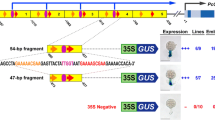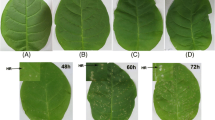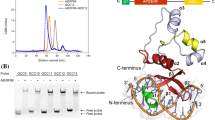Abstract
Ethylene transcriptionally activates a glutathione S-transferase gene (GST1) at the onset of the senescence program in carnation (Dianthus caryophyllus L.) flower petals. A 126 bp region of the GST1 promoter sequence has been identified as an ethylene-responsive enhancer element (ERE). In this paper, we demonstrate the ability of nuclear proteins from senescing petals to recognize a 22 bp sequence within the ERE (ERE oligonucleotide). Mutation of the ERE oligonucleotide sequence significantly alters the strength of this nuclear protein-DNA association. The wild-type ERE oligonucleotide sequence was used to isolate a cDNA clone encoding a sequence-specific DNA binding protein. Nucleotide sequencing and deduced amino acid sequence analysis of this cDNA predicted a 32 kDa protein which we have designated carnation ethylene-responsive element-binding protein-1 (CEBP-1). The mRNA expression pattern of CEBP-1 suggests that it is not transcriptionally regulated by ethylene. The amino acid sequence homology of CEBP-1 with other plant nucleic acid binding proteins indicates a conserved nucleic acid binding domain. Within this domain are two highly conserved RNA-binding motifs, RNP-1 and RNP-2. An acidic region and a putative nuclear localization signal are also identified.
Similar content being viewed by others
Abbreviations
- ERE:
-
ethylene-responsive element
- GST:
-
glutathione S-transferase
- RNP:
-
ribonucleoprotein
References
Bienz M: A CCAAT box confers cell-type specific regulation on the Xenopus hsp70 gene in oocytes. Cell 46: 1037–1042 (1986).
Broglie KE, Biddle P, Cressman R, Broglie R: Functional analysis of DNA sequences responsible for ethylene regulation of a bean chitinase gene in transgenic tobacco. Plant Cell 1: 599–607 (1989).
Christofferson RE, Warm E, Laites GG: Gene expression during fruit ripening in avocado. Planta 155: 52–56 (1982).
Cook WB, Walker JC: Identification of a maize nucleic acid-binding protein (NBP) belonging to a family of nuclear-encoded chloroplast proteins. Nucl Acids Res 20: 359–364 (1992).
Deikman J, Fischer RL: Interaction of a DNA binding factor with the 5′-flanking region of an ethylene-responsive fruit ripening gene from tomato. EMBO J 7: 3315–3320 (1988).
Deschamps S, Viel A Garrigos M, Denis H, leMaire M: mRNP4, a major mRNA-binding protein from Xenopus oocytes is identical to transcription factor FRGY2. J Biol Chem 267: 13799–13802 (1992).
Devereux P, Haeberli P, Smithies O: A comprehensive set of sequence analysis programs for the VAX. Nucl Acids Res 12: 387–395 (1994).
Didier DK, Schiffenbauer J, Woulfe SL, Zaceis M, Schwartz BD: characterization of the cDNA encoding a protein binding to the major histocompatibility complex class II Y box. Proc Natl Acad Sci USA 85: 7322–7326 (1988).
Didier DK, Klee HJ, Identification of an Arabidopsis DNA-binding protein with homology to nucleolin. Plant Mol Biol 18: 977–979 (1992).
Ecker JR, Davis RW: Plant defense genes are regulated by ethylene. Proc Natl Acad Sci USA 84: 5202–5206 (1987).
Itzhaki H, Woodson WR: Characterization of an ethylene-responsive glutathione S-transferase gene cluster in carnation. Plant Mol Biol 22: 43–58 (1993).
Itzhaki H, Maxson JM, Woodson WR: An ethylene-responsive enhancer element is involved in the senescence-related expression of the carnation glutathione S-transferase (GST1 gene). Proc Natl Acad Sci USA 91: 8925–8929 (1994).
Kozak M: Compilation and analysis of sequences upstream from the translational start site in eukaryote mRNAs. Nucl Acids Res 12: 857–872 (1984).
Landsman D: RNP-1, and RNA-binding motif is conserved in the DNA-binding cold shock domain. Nucl Acids Res 20: 2861–2864 (1992).
Lawton KA, Huang B, Goldsbrough PB, Woodson WR: Molecular cloning and characterization of senescence-related genes from carnation flower petals. Plant Physiol 90: 690–696 (1989).
Lincoln JE, Cordes S, Read E, Fischer RL: Regulation of gene expression by ethylene during Lycopersicon esulentum (tomato) fruit development. Proc Natl Acad Sci USA 84: 2793–2796 (1987).
Maniatis T, Fritsch EF, Sambrook J: Molecular Cloning: A Laboratory Manual. Cold Spring Harbor Laboratory Press, Plainview, NY (1989).
Mattaj IW: A binding consensus: RNA-protein interactions in splicing, snRNPs and sex. Cell 57: 1–3 (1989).
Meller Y, Sessa G, Eyal Y, Fluhr R: DNA-protein interactions on a cis-DNA element essential for ethylene-regulation. Plant Mol Biol 23: 453–463 (1993).
Montgomery J, Goldman S, Deikman J, Margossian L, Fischer RL: Identification of an ethylene-responsive region in the promoter of a fruit ripening gene. Proc Natl Acad Sci USA 90: 5939–5943 (1993).
Nagai K, Oubridge C, Jessen TH, Li J, Evans PR: Crystal structure of the RNA-binding domain of the U1 small nuclear ribonucleoprotein A. Nature 348: 515–520 (1990).
Oeller PW, Wong LM, Taylor LP, Pike DA, Theologis A: Reversible inhibition of tomato fruit senescence by antisense RNA. Science 254: 437–439 (1991).
Ohme-Takagi M, Shinshi H: Ethylene-inducible DNA binding proteins that interact with an ethylene-responsive element. Plant Cell 7: 173–182 (1995).
Ozer J, Fabers M, Chalkey R, Sealy L: Isolation and characterization of a cDNA clone for the CCAAT transcription factor EFIA reveals a novel structural motif. J Biol Chem 265: 22143–22152 (1990).
Pelham HRB, Brown DD: A specific transcription factor that can bind either the 5S RNA gene or 5S RNA. Proc Natl Acad Sci USA 77: 4170–4174 (1980).
Raghothama KG, Lawton KA, Goldsbrough PB, Woodson WR: Characterization of an ethylene-regulated flower senescence-related gene from carnation. Plant Mol Biol 17: 61–71 (1991).
Singh H, Sen R, Baltimore D, Sharp PA: A nuclear factor that binds to a conserved sequence motif in transcriptional control elements of immunoglobulin gene. Nature 319: 154–158 (1986).
Struhl K: Promoters, activator proteins and the mechanism of transcriptional initiation in yeast. Cell 49: 295–297 (1987).
Woodson WR: Changes in protein and mRNA populations during the senescence of carnation petals. Physiol Plant 71: 495–502 (1987).
Zeiner M, Gehring U: Cloning of 5′ cDNA regions by inverse PCR. Biotechniques 17: 1050–1054 (1994).
Author information
Authors and Affiliations
Rights and permissions
About this article
Cite this article
Maxson, J.M., Woodson, W.R. Cloning of a DNA-binding protein that interacts with the ethylene-responsive enhancer element of the carnation GST1 gene. Plant Mol Biol 31, 751–759 (1996). https://doi.org/10.1007/BF00019463
Received:
Accepted:
Issue Date:
DOI: https://doi.org/10.1007/BF00019463




